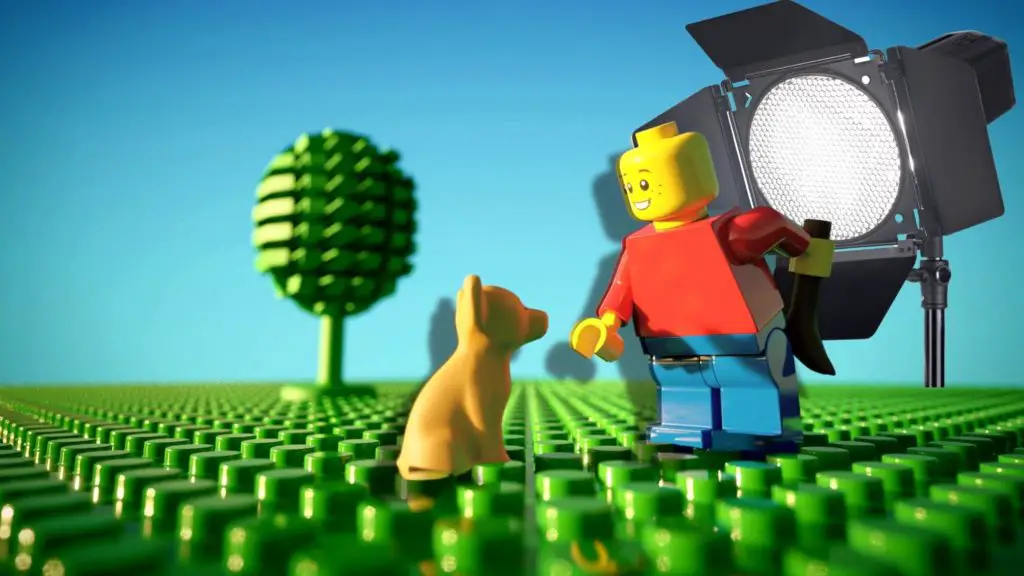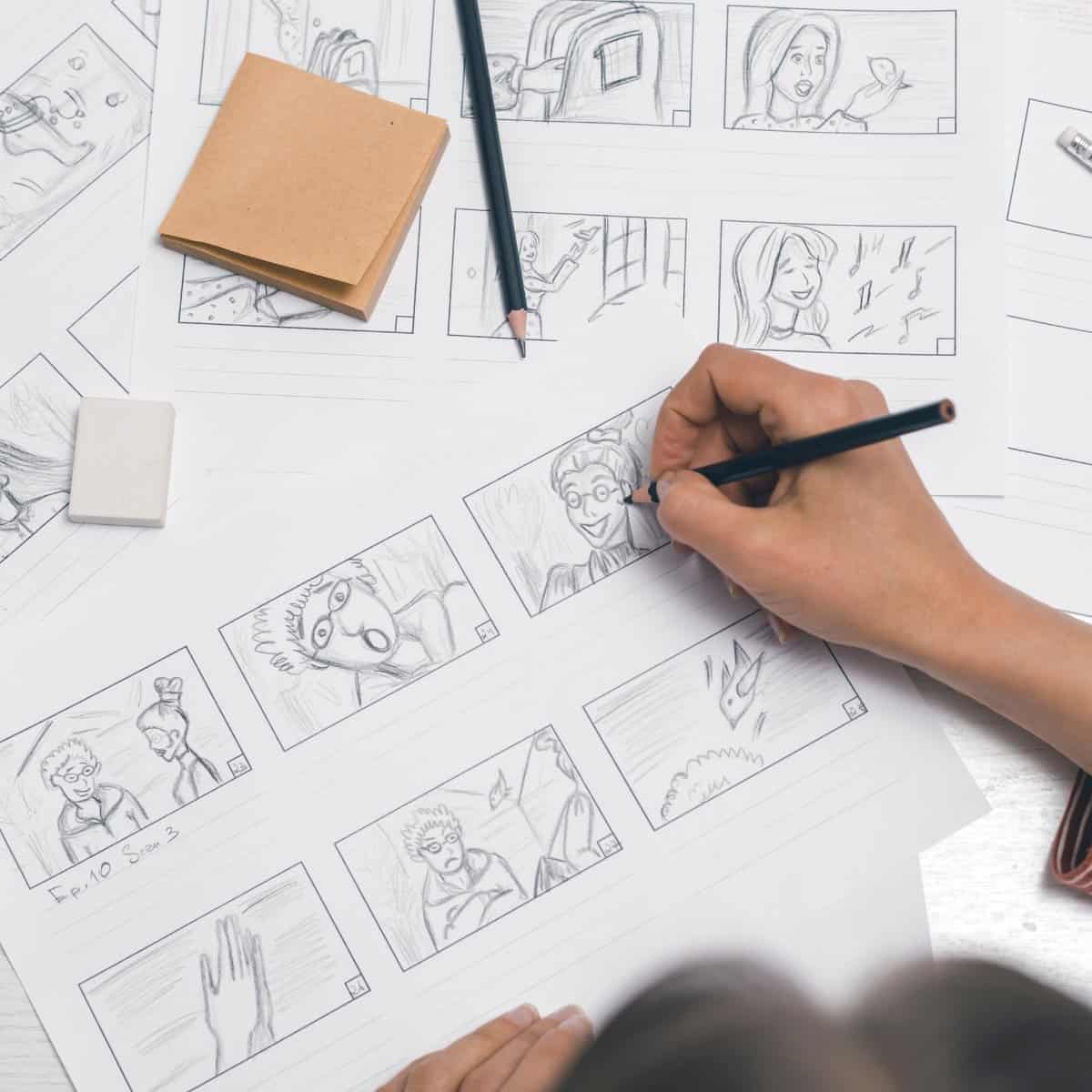Stop Motion Lighting 101: How To Use Lights For Your Set
A picture without exposure is a black image, it’s that simple. No matter how light-sensitive your camera is, you always need light to capture images.
There is a big difference between lighting and illumination.
With lighting, there is sufficient light available to capture an image; with lighting you can use light to determine an atmosphere or to tell a story.
That’s such a powerful tool in the world of stop motion video!

In this post we'll cover:
Lighting tips to make stop motion film better
Three lamps
With three lamps you can create a beautiful exposure. This method is often used in dialogue scenes.
First, you have a lamp on one side of the subject, the key light to sufficiently illuminate the subject.
That is usually a direct light. On the other side is a fill light to avoid harsh shadows, this is usually an indirect light.
A back light is placed at the rear to separate the subject from the background.
That back light is often a bit to the side, which gives you that typical light edge around the contour of a person.
- It is not a must to place the fill light on the other side, this can very well come from the same side at a different angle.
Hard light or soft light
You can choose a style per scene, often a type of lighting is chosen for the entire production.
Getting started with your own stop motion storyboards
Subscribe to our newsletter and get your free download with three storyboards. Get started with bringing your stories alive!
We'll only use your email address for our newsletter and respect your privacy
In hard light, the lamps are aimed directly at the subject or the location, in soft light they use indirect light or light with a frost filter in front of it or other filters to diffuse the light.
Hard light produces harsh shadows and contrast. It comes across as direct and confrontational.
If your production takes place in the summer with a lot of sunlight, it makes sense to also opt for hard light when shooting indoors to maintain continuity with outdoor scenes.
Soft light creates an atmospheric and dreamy style. The image is sharp but the soft light makes everything flow together. It literally exudes romance.
Constant light source
Even if you use film lamps, you have to take the layout of your scene into account.
If in the overall shot there is a table lamp on the left, in a close-up you also have to make sure that the main light source comes from the left.
If you’re filming in front of a green screen, make sure the exposure of the subject matches the exposure of the background that will be added later.
Colored light
Blue is cool, orange is warm, red is ominous. With color you very quickly give meaning to the scene. Make good use of that.
Contrasting left and right colors work well in action movies, blue on one side and orange on the other. You see that very often, our eyes find that combination pleasant to look at.
More light, more possibilities
A light-sensitive camera is practical, but it doesn’t add much to the artistic process.
Unless you consciously opt for natural light, as with the Dogme films of the 1990s, artificial light gives you many opportunities to better tell your story.
The way you light characters can tell a whole story, you can choose which parts in the image stand out or not.
Path to Enlightenment
Experimenting with light on movie sets is the best way to improve your skills.
Can you make stop motion with LED lights?
It has been popular in the low-budget stop motion world for some time, professionals are also increasingly switching to LED lamps in video and film productions.
Is that a good development or should we stick with the old lamps?
Be careful with dimmers
It is very easy if you can dim the LED lamps, even with cheap lamps there is usually a dimmer button. But those dimmers can cause the light to flicker.
The more the LEDs are dimmed, the more they will blink. The problem is, it’s hard to spot at what point that flicker is picked up by the camera.
If you find out afterwards during the editing, it’s too late. That is why it is wise to test the dimmers well in advance.
Make test shots and film with different dimmer settings and review the recordings.
If you are not sure, it is better not to use the dimmer and move or rotate the light source.
There are LED lamps with switches that allow you to choose how many are lit at the same time.
Suppose there are 100 members in total. Then you can switch between 25, 50 or 100 Leds simultaneously.
That often works better than using the dimmer. In all cases, it is a good idea to check the white balance before recording.
Use a Softbox
The light from LED lamps often comes across as harsh and “cheap”.
By placing a softbox in front of the lamps, you make the light more diffused, which immediately looks much nicer.
This makes it no different than with traditional lighting, but the need for a softbox with LED lamps is even greater.
Because LED lamps get less hot, you can also improvise with fabric or paper if you don’t have a softbox at hand.
Safe and comfortable
It is in line with the previous point but it may be mentioned separately; LED lamps are very pleasant to work with.
The housing is much more compact, which allows you to save a lot of space in tight situations.
It is also easy outside if you can conjure up a large box of light with a relatively small LED lamp and a battery.
Because LED lighting generates much less heat, they are also a lot safer to use.
Not to mention the cables that are no longer dangerously scattered on the floor and the use of electricity outdoors during a rain shower…
Choose the right color temperature
Nowadays, you can purchase LEDs with a specific color temperature. It is denoted in Kelvin (K). Note that you can get a shift in temperature with dimmers.
There are LED lamps with both cool and warm LEDs that you can switch on or dim separately. That way you don’t have to change the bulbs.
These lamps do have a larger surface area because of the double number of LED rows.
You have to pay close attention to LED lamps where you can adjust the color temperature. If you regulate the color temperature with each shot, there is a chance that the shots will not match well.
Then every shot in the post has to be adjusted, which can take a lot of time.
CRI the color quality
CRI stands for Color Rendering Index and varies between 0 – 100. Is a LED panel with the highest CRI value the best choice?
No, there are certainly other factors that are important, but take it into account when choosing an LED panel.
To make a comparison; The sun (for many the most beautiful light source) has a CRI value of 100 and tungsten lamps have a value of around 100.
The advice is to choose a panel with an (extended) CRI value of around 92 or higher. If you are in the market for LED panels, take a look at the following brands:
Not all LED lamps are solid
The old studio lamps used a lot of metal, heavy and solid materials. It had to be because otherwise the lamp would melt.
LED lamps are often made of plastic, which is a lot lighter to wear, but they are also often fragile.
This is partly a perception, plastic looks cheap, but with cheaper lamps it can happen that the housing cracks faster in the event of a fall or during transport.
The investment is higher
There are budget LED lamps for a few tens, which is very cheap isn’t it?
If you compare it with studio lighting, yes, but those cheap lamps are a lot more expensive than a construction lamp, you have to compare them with that.
High-quality, professional LED lamps are much more expensive than traditional lamps. You partly save on electricity, the biggest advantage is the lifespan and ease of use of LED lamps.
The number of burning hours is much higher, on balance you pay less for LED lighting, as long as you don’t drop them of course!
If you can’t choose…
There are studio lamps on the market that contain a normal lamp in combination with LED lighting. In principle, this gives you the advantages of both systems.
You can actually say that you have the disadvantages of both systems. In most
In some cases it is probably better to opt for one system.
Should you choose LED lighting for stop motion?
In principle, there are more advantages than disadvantages. The old-fashioned videographer may prefer to work with “normal” tungsten lamps, but that is subjective.
In almost every situation, LED lighting offers more advantages than disadvantages. Take, for example, these practical situations:
Inside a living room
You need less space, there is less heat development, with batteries as a power source, there are no loose cables on the floor.
Out in the field
You don’t need a generator that makes a lot of noise, the lamps are compact and easy to transport, there are also LED lamps that are (splash) waterproof.
On a closed movie set
You save energy, you can easily switch between color temperature and the lamps last much longer, so replacement is less relevant.
Budget or Premium LED?
The issue of color temperature, especially in combination with dimmers, is an important reason to invest in professional LED lamps. Make an informed judgment before choosing a specific brand or type of lamp.
Is renting an option or do you want to purchase lamps yourself? The long life of LED lamps makes it a good investment for the long term. And you get to know your own lamps.
If you decide to rent, it is wise to first take a number of test shots and check them on a reference monitor.
Just like you have to learn how to handle a camera, you also have to know the ins and outs of the lamps (if you don’t have a gaffer at your disposal ;)).
Conclusion
To lay a solid foundation you can purchase the Experience Lighting Masterclass and illumination Cinematography Workshop (via digital download) from Hollywood specialist Shane Hurlbut.
These workshops give a very good picture of how to highlight a “real” Hollywood film set and everything that comes with it. If you have little experience with light, it is definitely worth checking out.
It is quite an investment but it will take your knowledge to a higher level.
Unfortunately, lighting is often neglected in small budget/indie productions.
So a tip: instead of that Arri Alexa, rent a slightly smaller camera and a little more extra light for a better end result! Because light is really an essential factor in a film.
Hi, I'm Kim, a mom and a stop-motion enthusiast with a background in media creation and web development. I've got a huge passion for drawing and animation, and now I'm diving headfirst into the stop-motion world. With my blog, I'm sharing my learnings with you guys.
